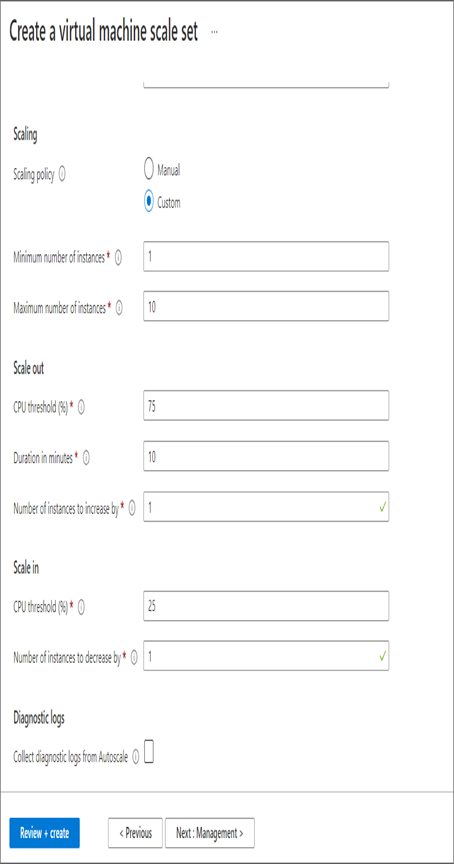By enabling autoscaling, you can automatically increase or decrease the number of application instances. In other words, you don’t have to worry about the unexpected demand. When there is demand, more instances are created automatically, and when there is no demand, the instances will be automatically deleted.
The advantages of using scale set include automatic capacity adjustment, less overhead, and scale based on schedule. Let’s learn how you can implement autoscaling in a scale set. During the creation process itself, you can enable autoscaling by setting the scaling policy to Custom in the Scaling tab. Nevertheless, you can always navigate back to the scale set and enable it as required.
As you change the scaling policy to Custom, you will see the following options (refer to Figure 7.14):
- Minimum number of VMs: Minimum value for autoscale
- Maximum number of VMs: Maximum value for autoscale
- Scale out CPU threshold: The value at which autoscaling will be triggered
- Number of VMs to increase by: The increment value whenever the scale-out rule is triggered
- Duration in minutes: How long the threshold value should be retained to trigger the rule
- Scale in CPU threshold: The value at which the scale-in rule will be triggered
- Number of VMs to decrease by: The decrement value whenever the scale-in rule is triggered

FIGURE 7.14 Enabling autoscaling
Summary
Though you worked with virtual machines in most of the previous chapters, in this chapter you got full coverage of virtual machines. We started the chapter with virtual machine planning, where you saw some of the vital decisions that you need to plan prior to deploying a VM. After that, you learned how to create Windows and Linux machines from the Azure portal.
After creating a VM, we discussed different methods by which you can connect to Linux and Windows VMs. We covered RDP, WinRM, and SSH. Also, we discussed the Azure Bastion service. This service is useful in establishing SSH/RDP connections from the Azure portal without the need to use public IP addresses. After covering virtual machines, we reviewed the availability options discussed in Chapter 5. You also explored the scaling concepts: vertical scaling and horizontal scaling.
Finally, we covered scale sets. This is an ideal solution for customers who want to increase or decrease the number of instances based on the demand. You also saw how you can implement the autoscaling rule to automatically scale in and scale out. So far, you created VMs from the Azure portal and using images that are available in Azure. Assume that you have a custom image and need to bring that image to Azure. In the next chapter, you will see how you can automate the deployment of resources using Azure Resource Manager templates, and you will also see how you can create custom images in Azure.